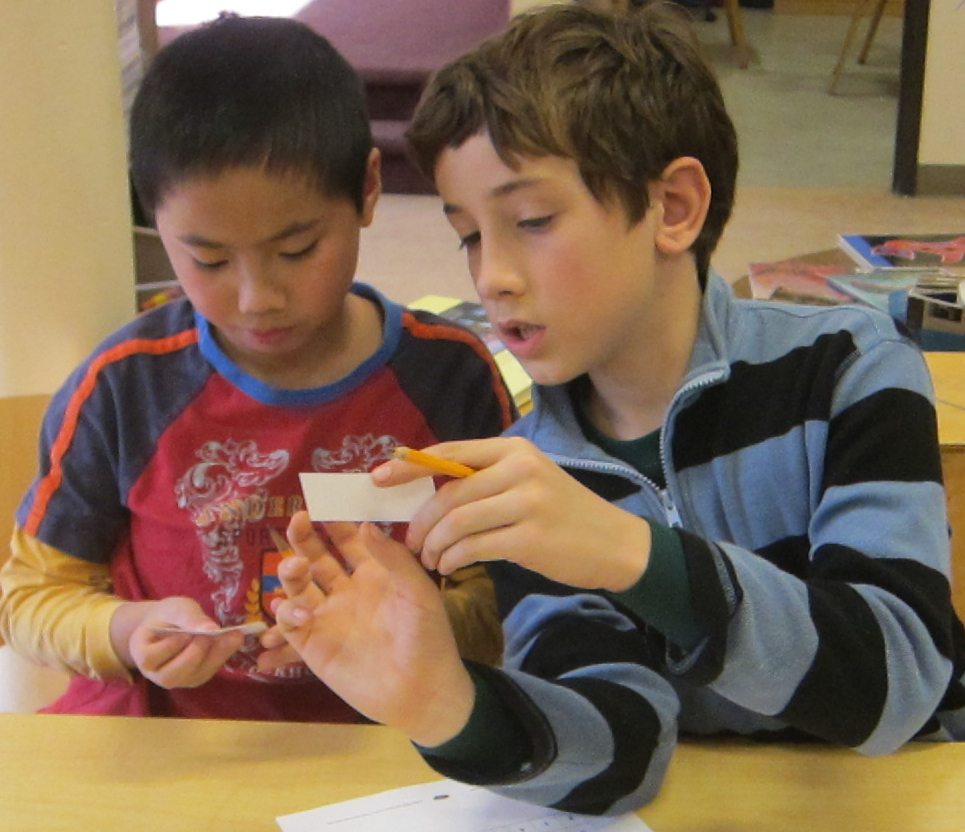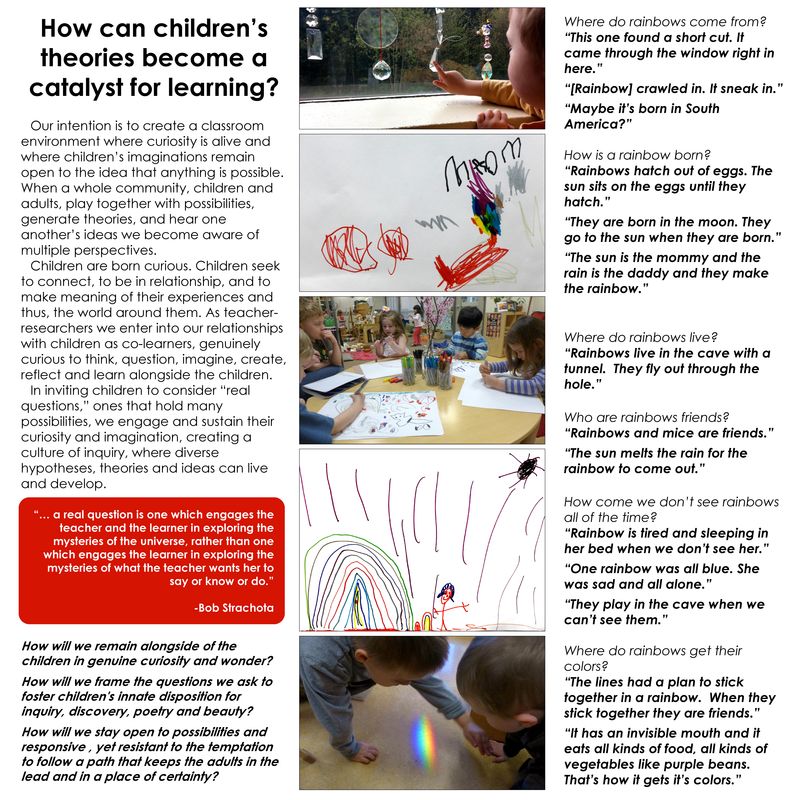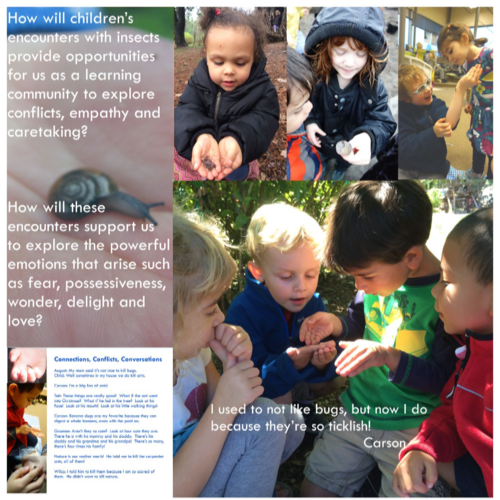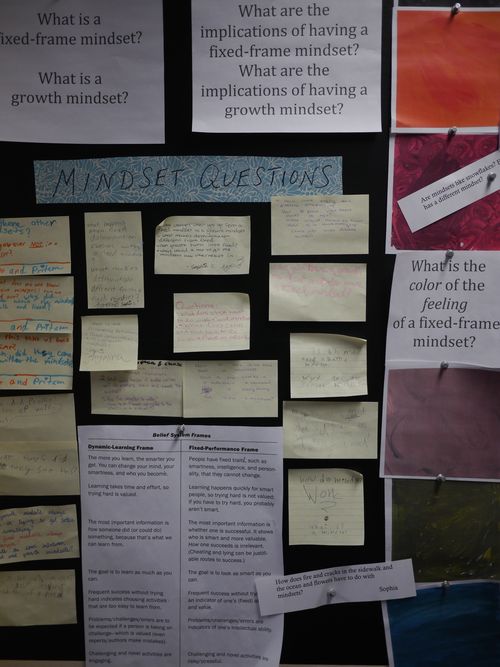Living in Questions


Visitors to Opal School are oftentimes struck by the quantity and quality of the questions they encounter here. At Opal School, we aim to live in inquiry. As the panel above reveals, questions allow us to remain alongside children in genuine curiosity and wonder. We immerse our questions whose answers point to the unknown, rather than singular answers; questions that may have never been answered – or even asked – before; questions that this group of individuals at this moment in this place will benefit from exploring together. Last week, I wrote about one such question set (How might we listen to the trees in Hoyt Arboretum?) and shared the thoughts of the group about why children might be the best group to pursue such a question.
Questions are omnipresent at Opal School. When we find conflict, teachers and students ask questions to move beyond assumptions we carry. As we read and write, we ask questions about authors intent. Questions provoke us to dive deeply into engagement with materials.
Questions are always audible – and they’re also visible. Knowing that Warren Berger, the author of A More Beautiful Question, along with Right Question Institute and a range of partner organizations have declared this #QuestionWeek, I journeyed across the school Friday to see what questions I’d find displayed in the classrooms.
To me, it’s clear that the questions hanging in the classrooms are there to stimulate adults and children alike. They emphasize communities where teachers and children are co-researchers, equally intrigued to make meaning from experience. They support relationships between and amongst children, adults, materials, and ideas. I find it intriguing to consider how questions found in classrooms of different ages reflect each other.
For your question-loving pleasure, the following is a list of questions I saw walking through the classrooms.
From Alder Classroom (Beginning School, Ages 3-5)
As we grow our relationship with the trees around us, what will we discover about ourselves and one another?
What connections and relationships are revealed trough playing with materials, ideas, and theories?
What are the unique ways in which each of us chooses to express our ideas?
How will children’s encounters with insects provide opportunities for us as a learning community to explore conflicts, empathy, and caretaking?
How will the encounters support us to explore the powerful emotions that arise such as fear, possessiveness, wonder, delight, and love?
How will we nurture and support children to explore the fullness of mark marking in the materials, time, and experiences we provide?
As we grow our relationship with the trees around us, what will we discover about ourselves and one another?
Who might your leaf person find in these materials? what stories might they tell?
What happens when stick and wire meet? What other materials might you introduce to stick and wire?
What might we learn from the children when we listen to their thoughts about numeracy and mathematical thinking?
How might their questions and ideas become provocations for others to explore?
How does this way of building curriculum attend to content standards in a way that is meaningful and connected to the interests of children?
What possibilities does this provocation hold for our classroom of builders?
What do we discover by snapping our ideas together?
What does it mean to snap ideas together? How does it feel?
What is peace?
How do we, as teacher-researchers, invite and communicate the guiding principle of children as collaborators in what we choose to nurture, pay attention to, and reflect back to our students?
One way is to capture moments for the children to reflect back on while asking questions that might sound like:
Tell me: What’s happening in this picture?
What does it mean to work together?
What does it sound like? feel like?
How do you know when you are doing teamwork?
What does it mean to listen to someone’s idea?
What is difficult about teamwork? What strategies do you use?
What is something that feels good about teamwork?
What happens when we hit someone in our community?
What does 100 look like?
How can we work together to free the water from the puddle?
What muddy adventures await?
How can children learn through play?
What is our obligation for providing and preserving open spaces surrounded by natural beauty for children?
How might we work together to capture fall?
What happens when our ideas connect?
What are you hoping will happen when people look at your gift for the birds?
From Cedar Classroom (Beginning School, Ages 3-5)
What would happen if all children in all parts of the world had the opportunity to explore, on a daily basis, what tit means to be human in the midst of diversity? (Karen Gallas)
Who are we as a community?
What does it mean to be an explorer?
How might blocks be a place to snap ideas together?
How can we build our ideas together?
What strategies can you use to solve a problem?
What did you learn about your friend?
What did you discover about yourself?
What do you know about collaboration?
What do you know about this word, collaboration?
What are some words that we’ve discovered can help us collaborate?
Can we play in blocks?
Can I play with you?
What does collaboration look like and sound like?
How do the children’s understanding of themselves and others get shaped through collaborative experiences?
What kind of collaboration is possible when it’s playful?
What language invites and supports collaboration?
What are the personal experiences and environmental conditions that nurture collaboration?
What would be lost if we did not invite young children to collaborate together?
What are the roles of connection, collaboration, and curiosity in supporting a culture of playful inquiry?
What’s necessary for collaboration to live inside a learning community?
How might the world be different if children were allowed to take time each day to create texts about themselves in relationship with others? (Karen Gallas)
How can we honor our approximations?
How do we support them along the way?
What might the world be like if we understood that each person was in their own stage of approximations for living life?
Why do we draw [peas] in different ways?
What do you notice?
As you play, what stories will you discover in these materials?
What do you see? What do you feel? What do you smell?
How can you use line and color to express emotions?
How can images nurture words and words nurture images?
How can reflecting on our thinking and feelings deepen our understanding of ourselves and others?
What do you know and love about clay?
What does it mean to be an explorer?
What new possibilities exist within a familiar material?
What happens when we invite children to slow down and capture what they see?
From Maple Classroom (Charter School, Grades K-1)
When children create a world together from their collective imaginations, strengths, and joy, what becomes possible?
What is a community?
What happens when we find the “unfamiliar” in nature? Where in nature and play do you find the unfamiliar?
What sort of treasures do you feel live in the Arboretum? Are they hidden treasures? Are they spectacular?
What does a message to a friend sound and look like?
What do you think the Arboretum needs or wants from us?
What does it look/feel/sound like to draw with a partner?
What word or words capture your exploration today? What ideas did you find in your play?
What is possible underground?
What kinds of things do writers make?
What do you do when you want to write a word you don’t know?
What happens in our brains when we do math?
What does it mean for kindergarten and first grade authors to publish?
What is the importance of support from the teachers?
How do we put the act of publishing in the hands of the writer and maker?
What do we do when we are reading?
From Magnolia Classroom (Charter School, Grades 1-2)
What is the reciprocal relationship between play, belonging, and the natural world?
How will these relationships help us learn about ourselves and one another?
How might we invite children to reflect upon these relationships?
What surprises will you uncover when you slow down and zoom in on the roots?
What materials do you need to help you grow…
your ideas?
your stories?
your research?
What do you do when you come to a word you don’t know?
What do Magnolia readers recommend?
How does the setting of the natural word influence the relationship between play and writing? … and how can the children teach us about these relationships?
How do stories connect us?
What ideas will we build together?
What role do materials play in building relationships?
How will these shared experiences of thinking help us to begin to understand ourselves and one another better?
How will children’s interest in drawing and design inform our work together? What is the role of mark-making in sharing? What is important to each of us while uncovering what is important to all of us?
What does that make us think? wonder? feel?
What does it feel like to collaborate?
From Opal 3 Classroom (Charter School, Grade 3)
How might we express the mystery of friendship through words and images?
What does it man to be a friend?
What do friendships need in order to grow and flourish?
What happens when things go wrong?
What does it mean to be an active participant within a friendship?
Why do things go wrong sometimes and what would the world be like if they didn’t?
Who are you as an idea maker?
How might drawing help you see in a new way?
How does observational drawing allow us to consider multiple perspectives?
What happens when we slow down to look closely?
What can charcoal do?
What colors live inside black?
What happens when we draw from the inside out?
What lives in your heart?
What is friendship?
How do YOU know the moon?
All the same. No new ideas. No disagreement. No risk. What happens to emotion?
How are seeds like ideas?
From Opal 4 Classroom (Charter School, Grades 4-5)
What leads people to act for others as well as themselves? What happens when they do?
How can we develop a stronger understanding of the past?
How can we gain a sense of the experiences and environments and the hopes and fears of people and places from far away and long ago?
How could playful inquiry help?
How does that connect to you?
What becomes possible through historically realistic play?
How does history help us live our lives?
How do we know when a community of learners are engaged in playful inquiry?
Why do different people see the world in different ways?
What happens when people with different world views come together?
What did [the Taino and the Columbus expedition] perceive, believe, and care about?
How can we move from recognizing that there are different perspectives to seeking understanding of those perspectives?
How can we develop a dispositional view of thinking? what habits of mind can we cultivate by slowing down to organize and extend our thinking?
What is the relationship between curiosity and critical thinking?
What is a fixed-frame mindset? What is a growth mindset? What are the implications of having a fixed-frame mindset? What are the implications of having a growth mindset? What is the color of the feeling of a fixed-frame mindset?
What do you see? What do you think? What do you wonder?
Why do we reflect?
How can playful inquiry nurture empathy and advocacy?
What did people do to help?
What does it mean for a school to be guided by a pedagogy of play? What might we learn?
What can we take from the stories of history?
This transcript from a conversation in September sits next to where the class meets daily:
AG: You have a choice to learn and most people come here to learn and the teachers too. They don’t just come here to teach – they come here to learn. You can either learn or have a hard time with it. You can choose to learn and then your brain learns more and more. That’s why you ask us a lot of questions – so we can think and learn and have the correct answer.
LD: Well, a lot of things like this don’t have a right answer.
SM: And questions that just bring out more questions.
LD: Like, you have to get a key to unlock the door or you just break down the door, but that might mess up someone else’s thinking. If there is just one right answer and the teacher says, “that’s right” – but that can shut down people’s thinking.
SN: You might try to figure it out, and someone could just tell you, and that might be breaking down the door.
AG: Someone had a different answer and Hannah said that’s a key to helping you figure it out. Failure is one of the most important thing to learning.
PK: Hannah likes it when we get different answers because we get to have a discussion.
SM: Kind of like in group work. You might not have the right answer, but you would still get something from it. If your groupwork doesn’t go how you planned, you still get something from it.
AG: Sometimes problems are useful.
What do you notice? What do you wonder about? How are you using questions to unlock the door to useful problems – during #QuestionWeek and throughout life?



